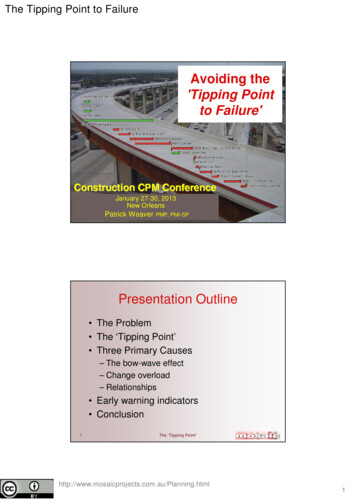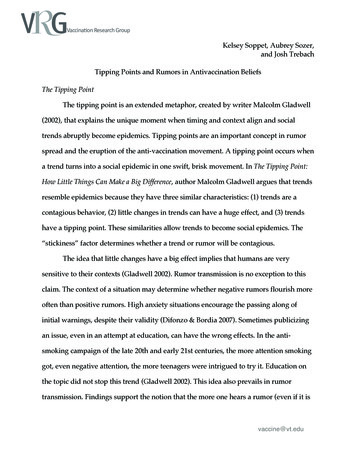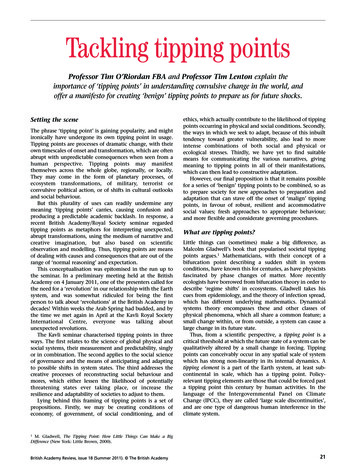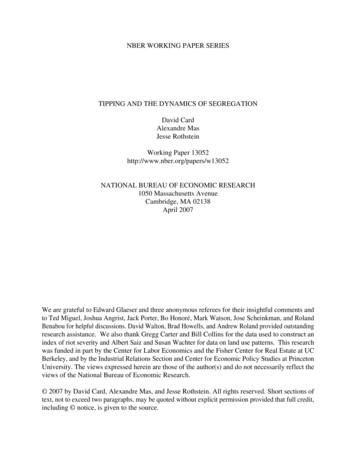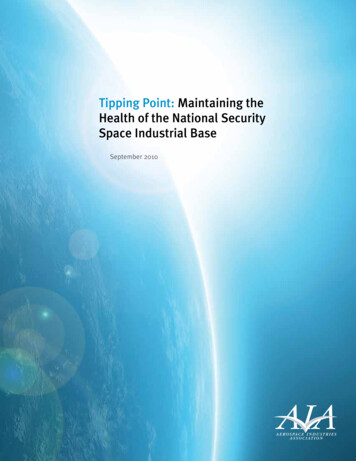
Transcription
Tipping Point: Maintaining theHealth of the National SecuritySpace Industrial BaseSeptember 20101
Crescent MoonA last quarter crescent moon above Earth’s horizon isfeatured in this image photographed by the Expedition24 crew on the International Space Station.Photo courtesy of NASA2
September 2010Tipping Point: Maintaining the Health of the National Security SpaceIndustrial BaseAIA released a report to the new administration and Congress in January 2009 on the importantrole America’s space efforts play in the everyday lives of our citizens, our economy and nationalsecurity. That report, The Role of Space in Addressing America’s National Priorities, providedindustry’s perspective and recommendations for the path forward on a variety of the major spaceissues confronting our nation’s policy makers.In July 2009, AIA released a report, The Unseen Cost: Industrial Base Consequences of DefenseStrategy Choices, that laid out the case for narrowing the gap between the Defense Departmentview of industry as an always ready supplier of military capabilities and how industry actuallymakes decisions on what capabilities it can offer.In this new report, Tipping Point: Maintaining the Health of the National Security Space IndustrialBase, AIA expands on the national security space sections in our earlier reports.As discussed in The Unseen Cost, critical industrial base challenges already exist for the nationalsecurity space sector. Moreover, The Role of Space highlights the increasing threats that today’snational security space capabilities face and points out that space is relied upon by our economy,military, Intelligence Community and national leaders more today than at any point since the dawnof the space age.The new National Space Policy and review of Defense Department Space Posture will help lay thegroundwork for future government policy in national security space. However, changes in policyalone won’t be sufficient to address the new challenges our nation faces. It’s more critical thanever that new policy be backed by strong leadership, integrated strategy and the long-term fundingand stability needed to maintain cutting-edge, cost-effective space programs.As other nations make rapid advancements in acquiring or exploiting space capabilities, America’sleadership in space is no longer guaranteed and the security of our space assets is no longerassured.Given the growing U.S. dependence on these systems and their contribution to the globaleconomy, our nation cannot afford to lose its preeminence in space. We must take the necessarysteps to restore and maintain the vitality of our national security space programs to avoid a crisisbeyond which irreparable harm occurs to our nation’s defense and economic success.Sincerely,Marion C. BlakeyPresident and Chief Executive Officer3
Executive Summary . . . . . . . . . . . . . . . . . . . . . . . . . . . . . . . . . . . . . . . . . . . . . . . . . .Looking Down on EarthClouds and sunlight over the Indian Ocean, as seenfrom Discovery during the STS-96 mission in 1999.Photo courtesy of NASA46
ContentsI. Introduction . . . . . . . . . . . . . . . . . . . . . . . . . . . . . . . . . . . . . . . . . . . . . . . . . . . . .8II. Evolving Role of National Security Space Systems in U.S. Security . . . . . . . . .9III. National Security Space Today . . . . . . . . . . . . . . . . . . . . . . . . . . . . . . . . . . . . .9Global Communications . . . . . . . . . . . . . . . . . . . . . . . . . . . . . . . . . . . . 10Imaging and Surveillance from Space . . . . . . . . . . . . . . . . . . . . . . . . .11Missile Defense . . . . . . . . . . . . . . . . . . . . . . . . . . . . . . . . . . . . . . . . . . .11Positioning, Navigation and Timing . . . . . . . . . . . . . . . . . . . . . . . . . . .11Space Launch . . . . . . . . . . . . . . . . . . . . . . . . . . . . . . . . . . . . . . . . . . . . . 12IV. Key National Security Space Challenges . . . . . . . . . . . . . . . . . . . . . . . . . . . . . . 12Export Barriers . . . . . . . . . . . . . . . . . . . . . . . . . . . . . . . . . . . . . . . . . . . . 13Shrinking Workforce and Budget Instability . . . . . . . . . . . . . . . . . . . . 14Acquisition Process . . . . . . . . . . . . . . . . . . . . . . . . . . . . . . . . . . . . . . . . 16Space & Cyberspace Protection and Space Situational Awareness . . . 17Trade and International Partnership . . . . . . . . . . . . . . . . . . . . . . . . . . 19Operationally Responsive Space . . . . . . . . . . . . . . . . . . . . . . . . . . . . . 20Strategic Systems & Missile Defense . . . . . . . . . . . . . . . . . . . . . . . . . 21V. AIA Recommendations . . . . . . . . . . . . . . . . . . . . . . . . . . . . . . . . . . . . . . . . . . . . 22VI. Conclusion . . . . . . . . . . . . . . . . . . . . . . . . . . . . . . . . . . . . . . . . . . . . . . . . . . . . . . 27Appendix: Overview & History of National Security Space . . . . . . . . . . . . . . . . . . 30Glossary . . . . . . . . . . . . . . . . . . . . . . . . . . . . . . . . . . . . . . . . . . . . . . . . . 32Endnotes . . . . . . . . . . . . . . . . . . . . . . . . . . . . . . . . . . . . . . . . . . . . . . . . . 37AIA Member Companies . . . . . . . . . . . . . . . . . . . . . . . . . . . . . . . . . . . . 405
E X E C U T I V E S U M M A RY:I. IntroductionNational security space systems provide missile warning and defense; global communications;environmental monitoring; global positioning, navigation and timing; launch capability, andintelligence, reconnaissance and surveillance. They are the bedrock of our 21st century militarycapabilities and part of our economy’s critical infrastructure. Yet in light of an increasinglycontested, congested and competitive space domain – and a national security space industrialbase that is increasingly fragile – it is more important than ever to match policy goals with strongleadership, integrated strategy and the long-term funding and stability needed to maintain cuttingedge and cost-effective space programs.II. Evolving Role of National Security Space Systems in U.S. SecuritySince the dawn of the space age, military and intelligence space programs have been critical to ournational defense. During the early years, national security space efforts were matched with cleargoals and strong funding levels. However, in today’s world national security space systems face anarray of increased requirements and funding pressures.III. National Security Space TodayWhile not widely understood by the general public, a look across today’s national security spacesector shows a variety of critical technologies and skills that are needed for robust national andhomeland defense.National Security Space provides: Global communications Imaging, surveillance and environmental monitoring from space Missile warning and defense Positioning, navigation and timing Space launchIV. Key National Security Space ChallengesExport restrictions, unstable funding, the lack of a national security space strategy and strains inthe U.S. workforce are placing pressure on U.S. space systems suppliers and manufacturers, whichthreatens U.S. space economic leadership.Other priority areas: Space and cyberspace protection and space situational awareness Trade and international partnership Operationally Responsive Space Strategic systems and missile defenseV. AIA RecommendationsA coherent and long-range strategy for national security space systems must be matched withstable budgets and funding levels.Recommendation #1 – Establish Leadership and Program Stability.National level leadership is needed for the space sector that provides: A long-term national security space system investment strategy Multi-system procurement strategies important for space industrial base health Balanced and stable budgets and funding that are critical to maintaining cutting-edgenational security space programs6
Recommendation #2 – Modernize & Maintain Infrastructure.National security space systems are a critical infrastructure and they must be sustained andmodernized across areas such as: Liquid and solid rocket propulsion Military satellite communications Missile warning and defense Operationally Responsive Space Positioning, navigation and timing Selected space optics, overhead imaging and non-imaging sensors Supply chain and componentsRecommendation #3 – Modernize Export Control Policies and Promote Industry’s Abilityto Compete.AIA recommends that the U.S. government complete a careful review of space technologies– including commercial satellite technology – to reevaluate which technologies should becontrolled at what level and to determine the most appropriate jurisdiction, while keeping ourprimary focus on national security concerns.Recommendation #4 – Support Current and Future Workforce.Make science, technology, engineering and mathematics education a national priority.Recommendation #5 – Focus and Support Robust Funding for Research andDevelopment and Science and Technology Efforts.Recommendation #6 – Ensure the Protection and Responsiveness of U.S. Space andCyberspace Capabilities.Steps needed to protect U.S. space capabilities: Support robust funding for space and cyberspace protection, including funding for the AirForce Space Command and NRO joint Space Protection Program Develop and fund significant investments in space situational awareness (SSA) capability Collaboratively address the issue of orbital debris mitigation and remediation Implement a plan for leveraging commercial SSA and sharing appropriate capabilities withcommercial space operators Maintain stable funding levels for Operationally Responsive Space that utilize industrycapabilities to enable responsive, affordable, on-demand space support for nationalsecurity operations and the U.S. warfighterVI. ConclusionDue to growing international competition, outdated export control policies and challenges facingour domestic workforce, the U.S. national security space industrial base is increasingly fragile.Adequate funding and a long-term strategy are more important than ever to ensure a healthyindustrial sector that is able to meet government’s mission needs.We must restore the vitality of our national security space programs to prevent irreparable harm toour nation’s defense and economic success.7
Photo courtesy of U.S. Air ForceUnmanned Aerial Vehicle controlled via satellite communications linkI. IntroductionTipping Point: Maintaining the Health of the National Security SpaceIndustrial BaseToday’s national security space assets have become critical components of the U.S. military,our national security and our economy. Once seen strictly as “strategic” assets for use by theIntelligence Community and national leadership, today’s space systems are now enabling virtuallyevery critical capability supporting the U.S. government and our warfighters: command and controlof unmanned aerial vehicles (UAVs); weather and climate monitoring; improvised explosive device(IED) detection; global positioning, navigation and timing; global communications; precision strikeand missile defense. In addition, national security space systems once relied upon solely by theU.S. government are now a vital part of our critical economic infrastructure.With the increasing importance of space to our economy, warfighters and national security, thespace domain faces very serious challenges. According to government leaders and the DefenseDepartment’s preliminary Space Posture Review, other countries are making significant advancesand today’s space environment is more “contested, congested and competitive” than ever.1More than 60 nations today are engaged in space efforts. Both China and India are investing inlaunch systems whose costs rival U.S.-manufactured systems. From 2005 to 2008 China conducted26 space launches that achieved Earth orbit or beyond, according to AIA’s 2009 Aerospace Factsand Figures. In that same period India conducted seven launches, with significant increasesplanned by the Indian Space Research Organization for the future. Russia and the European SpaceAgency conducted 94 and 23 launches respectively during that period. U.S. space launches duringthat timeframe stood at 72, well behind Russia.2Current U.S. export control policies for space systems often harm U.S. industry. Outdated policiesfor commercial satellites and related items have decreased America’s worldwide share of theglobal satellite market. This poses challenges to the U.S.’s ability to lead space partnerships withour allies abroad, weakens our ability to compete and ultimately wreaks havoc on our domesticspace industrial base and security.8
In addition, program cancellations and changes at NASA and the Defense Department are furtherexacerbating workforce deficiencies that will impact future U.S. space efforts. The number ofnational security space suppliers is dwindling. Loss of U.S. suppliers and their robust pool of spaceprofessionals endangers our nation’s lead in producing the world’s preeminent space technologies,especially as other nations graduate thousands more engineers than the United States.3With competitors making rapid advancements in acquiring or exploiting space capabilities,American leadership in space is no longer guaranteed and the security of its space assets is nolonger assured. Given the growing U.S. dependence on space systems and their contribution to theglobal economy, our nation cannot afford to lose its preeminence in space. We need to maintain –and in some cases restore – the vitality of our space programs to prevent irreparable harm to ournational economic and security interests.II. Evolving Role of National Security Space Systems in U.S. SecurityMost Americans are familiar with the role fighter aircraft, submarines and tanks play in nationalsecurity. However, because satellites are not readily visible, the importance of space infrastructureis not always recognized. Yet military and intelligence space efforts have grown from the dawn ofthe space age to become absolutely critical to our national defense and economy.Industry has played a key role in developing space systems for the U.S. government since thebeginning of the space age. In author Neil Sheehan’s A Fiery Peace in a Cold War, the story oflegacy aerospace companies like Convair and TRW and the race in the 1940s and 50s to buildnational security space launch and reconnaissance technology for the U.S. military and IntelligenceCommunity is an important chapter in space history.4The early years of national security space were characterized by our national needs during theCold War. U.S. national security space efforts were distinguished by clear national priorities, stablefunding levels, a growing and diverse industrial base and a good degree of risk tolerance. Forinstance, the National Reconnaissance Office’s (NRO) acclaimed Corona program endured despitetwelve successive launch failures.5 The national drive to achieve and maintain U.S. leadership inspace helped achieve many of the truly amazing space capabilities upon which our troops, nationalleaders and economy rely today.III. National Security Space TodayThe Persian Gulf War of 1990-1991 marked a significant milestone in the evolution of nationalsecurity space. Deemed by some as the nation’s first “space war,” it was the first time that the U.S.military relied on space systems and their capabilities for much of its operations. Space systemssupported soldiers in the field, Patriot anti-missile systems and air and sea operations. Accordingto the Defense Department, more than “90 percent of communication into and out of this theaterwent over communications satellites.”6By the new millennium, space systems were not only fully integrated into military operations, butbecame more and more interwoven into the fabric of the modern information-based U.S. economy.However, organization of U.S. national security space operations did not keep pace with thesechanges. A Space Commission was established by Congress in 2000 to examine the organizationand management of national security space activities. And in 2008, another group of nationalleaders highlighted the importance of national security space as part of the National Security SpaceIndependent Assessment Panel. One significant concern in the report was that at a time whennational security space is relied upon more than ever, no single agency or leader was in charge.9
Photo courtesy of U.S. Air ForceAdvanced Extremely High Frequency joint service satellite communications systemToday’s national security space systems are now integrated into virtually all aspects of oureconomy. Space systems provide modern business communications, commercial remote sensingand digital television and music for millions of consumers. Space system industry sales in 2009topped 40 billion, bolstering thousands of American jobs.7Federal funding remains a driver for the industry, and for national security space systems itaccounted for more than half the 42.6 billion the U.S. government spent for space capabilities in2008.8 Industry continues to develop and build the government and commercial systems that arevital to our defense and economic health, contributing billions of dollars to our GDP.9 Without U.S.industry and its workforce, we would lack a resource capable of developing, building and operatingthe critical space systems.A review of today’s key space capabilities shows their importance to the warfighter, U.S. defenseand economic success.Global communicationsIn today’s challenging battlefield environment, our warfighters must be able to communicaterapidly in remote, hard-to-reach regions of the world. As demand for technology that carriesintelligence and information to our deployed forces increases, global military satellitecommunications play an essential role in keeping our warfighters in contact with their fellowsoldiers and providing them support. Satellite communications help power UAVs and also helpkeep troops in contact with their families – a key element in maintaining morale during lengthydeployments.During the Cold War, national security space satellite communications largely consisted of systemsdesigned to provide communications for the president and secretary of defense in time of nuclearwar. Today, these types of survivable systems are still needed, but have other missions as well.Commercial communications satellites are also increasingly integrated into the broader globaleconomy, providing satellite phone service, satellite television, satellite radio and other services tothe public.10
There are a variety of systems currently in orbit that provideimaging, geospatial, weather monitoring and other sensingcapabilities to the U.S. military and everyday citizens. Accordingto an April 2010 commentary in Space News by Alden Munson,former deputy director of National Intelligence for Acquisitionand Technology, the need for climate monitoring satellites formilitary and intelligence purposes is critical.10 Climate monitoringsatellites help us better understand climate change and forecastweather to ensure safe transportation of our troops worldwide.With support from the National Geospatial-Intelligence Agency,imaging satellites provide critical intelligence to protect ourtroops. Today commercial satellite imagery is also commonplace Satellite imagery of oil moving into Louisiana’s coastal wetlands– just look at the wealth of information available publicly oversuch programs as Google Earth. Imagery satellites helpedour nation respond to Hurricane Katrina in 2005 and to the 2007 California wildfires.11 Imagerysatellites have also been used in 2010 to monitor the oil spill threatening the environment andeconomies of the Gulf Coast.12Photo courtesy of NASAImaging and surveillance from spaceAnother key space surveillance capability is missile warning. When missiles are launched anywherearound the world, missile warning systems allow the United States to quickly detect and trackthose missiles and determine whether they are a threat.Missile DefenseToday’s missile defense is an integrated, layered architecturethat helps provide multiple opportunities to intercept enemymissiles. In addition, international cooperation with friends andallies such as Japan, the U.K., Australia, Israel and others helpsensure wide coverage of missile defense capability.13Photo courtesy of Missile Defense AgencyToday, the U.S. Missile Defense Agency employs a missiledefense architecture designed to intercept missiles launchedagainst our troops, homeland, friends and allies. Withnations such as North Korea and Iran developing increasinglysophisticated long-range missiles, missile defense has becomea must-have for protection.Space Tracking and Surveillance System monitoring missile launchPositioning, Navigation and TimingThe Global Positioning System, originally designed for military use, is now relied on for manycommercial applications including online banking transactions, ATMs, agriculture, air traffic andground transportation systems and by emergency responders.As of March 19, 2010, there were 35 satellites in the GPS constellation according to the NationalExecutive Committee for Space-Based Positioning, Navigation and Timing.14 Today the civilianmarket for GPS is worth nearly 5 billion. Maker of GPS hardware and software Garmin Ltd., sawtotal 2008 sales of 3.5 billion, more than doubling 2006 sales, according to Space News.1511
Photo courtesy of NOAAOne of over 20 GPS satellites that transmit radio signals to EarthGPS helps farmers make more effective use of their land,directly contributing to lower maintenance costs and increasedcrop yields by allowing them to more efficiently sow seeds,till, water, fertilize, apply pesticide and map field boundaries.Personal smart phones are also increasingly connected to theGPS network. Overnight delivery services are integrating GPSinto their transportation vehicles to move goods faster fordelivery and commercial aircraft increasingly rely on GPS fornavigation. The Federal Aviation Administration is pursuinga major effort to modernize air traffic control and flightnavigation by upgrading outdated radar systems to satellitebased systems.16Space LaunchOf course, none of the key space capabilities would be possible without the means to getspacecraft into orbit such as the Defense Department’s Evolved Expendable Launch Vehicle (EELV).Delta IV and Atlas V rockets are designed for a high degree of reliability and are able to launchlarge amounts of payload into orbit, including large satellites and smaller secondary payloads.According to a 2006 RAND Corporation report, the Atlas V and Delta IV were developed withsignificant amounts of private investment to serve commercial customers. When commercialcustomers did not materialize, the U.S. government became the sole user of EELVs. The RANDreport concludes that the technology embedded in the EELV rocket families has a high degree ofreliability and “should be able to meet national security space needs through 2020 and beyond.”17The EELV family has had more than 70 successful launches in the past ten years.18SummaryIn essence, virtually all military operations – and even many critical civilian economic functions –rely on national security space. The services require national security space for warfare planning,environmental monitoring, missile warning, situational awareness, secure communications,disaster relief and humanitarian assistance. The nation relies on space systems and the industrythat provides them for missions that are increasingly complex and important to U.S. globalpreeminence.IV. Key National Security Space ChallengesThe industrial base that underpins national security space systems is increasingly fragile. The chartbelow, cited in AIA’s report The Unseen Cost, provides a perspective on overall consolidation inthe defense industrial base. Consolidation is particularly apparent in the national security spacesector, with only one new entrant in the liquid-fueled launch sector in recent years.Increased consolidation has placed limitations on industry competition, leaving some companiesas the only providers of core U.S. national security space capabilities. As a result, whengovernment makes decisions to cut or cancel programs, these decisions can have a dramaticimpact on the remaining companies and workforce. In addition to industrial base challenges, otherissues such as international partnership, space protection and missile defense must be grappledwith in order to maintain our security and space capabilities.12
Industrial Base Challenges: Export BarriersA variety of very serious challenges are negatively impacting the health of our national securityspace industrial base. At the forefront of these challenges are the strains created by our nation’sexport control policies for space technology.In 2008, AIA participated in the working group that produced a Center for Strategic andInternational Studies (CSIS) study titled, The Health of the U.S. Space Industrial Base and theImpact of Export Controls. This important study was commissioned to address rising concernwithin the national security space community.The findings showed that export restrictions have hit our nation’s space companies, especiallythe space supplier base, particularly hard. According to CSIS, the United States dominated theglobal satellite export market at more than 70 percent of worldwide share in 1995. Three yearslater, Congress passed a law that moved the export classification of commercial communicationssatellites to the International Traffic in Arms Regulations (ITAR) regime, which was intended toprotect sensitive space technologies and preserve U.S. preeminence in space. While intentions mayhave been good, the results were disastrous. According to the CSIS report, contract awards to U.S.companies for commercial communications satellite manufacturing dropped more than 20 percentby 2000, and by 2005 the United States’ worldwide share of the global satellite export market stoodat a mere 25 percent.19ITAR hasn’t slowed down the spread of space technology as more than 60 nations are engaged inspace activities today. Since the U.S. law was changed, many companies in Europe and elsewhereSignificant Industry Consolidations1993 1994 1995 1996 1997 1998 1999 2000 2001 2002 2003 2004 2005 2006 2007Hawker De Havill and Ltd (Australia)Hughes Space & Communications UnitsLitton Precision GearBoeingBoeingRockwell Aerospace & Defense unitsMcDonnell DouglasSolipsysChrysler Electronics & Aircraft Up grading unitsE-SystemsRaytheonRaytheonHughes ElectronicsTexas Instruments ElectronicsAllied SignalScaled CompositesLogiconGrumman & Vought AircraftNorthropWestinghouse DefenseTeledyne Ryan AeronauticalLitton & Newport News ShipbuildingTRWGeneral Dynamics SpaceGE AerospaceMartin MariettaGeneral Dynamics Ft. WorthLockheedLoral (including IBM Federal Systems & Unisys)National Steel & Shipbuilding CompanyLockheed Martin armaments unitsBath Iron WorksGeneral DynamicsNorthrop GrummanLockheed MartinGeneral DynamicsGulfstream AerospaceGalaxy AerospaceAdvanced Technology ProductsGeneral Motors Defense, Steyr Daimler Puch Spezialfahrzeug & Datron’s IMCO unitSpectrum AstroConsolidation of the aerospace and defense industry over time13
actually tout their satellites and components as “ITAR-free.”20 Commercial satellites are nowthe poster child for the need to modernize the U.S. export control system. U.S. firms are forcedto navigate an extremely challenging pathway to gain export approval under ITAR. Even moretroublesome, all parts of a commercial satellite – no matter how innocuous – are restricted andconsidered munitions list items. This poses challenges to the United States’ ability to lead spacepartnerships with our allies abroad and is wreaking havoc on our domestic space industrial base.With outdated and unduly restrictive export control policies, our nation has in effect forced thespace industry to rely on the U.S. government for its survival and prevented the development of arobust commercial base for the U.S. space industry. According to CSIS, 60 percent of the industry’srevenues are tied to national security, and when civil government space is included, nearly 95percent of the industry’s revenues are tied to the U.S. government.21A 2008 survey by the National Security Space Office of nearly 200 small U.S. space companiesfound that 70 percent of those companies surveyed stated that ITAR restrictions inhibited theirability to compete for foreign business. More than 40 percent of companies cited ITAR restrictionsfor hiring difficulties. Many of the survey’s findings show that our nation’s small space businessesare the most vulnerable to fluctuations in government funding and compliance burdens.22 Smallbusinesses are the foundation of any strong and innovative industry, but export restrictions posereal challenges to sustaining and growing the supply chain.At a time when the U.S. government should be encouraging growth across all sectors of the economy,export controls are limiting growth in the space sector, especially among component suppliers. Inthe absence of a healthy, cutting-edge U.S. space industrial base our government may be forced intoreliance on foreign suppliers for key components, accelerating the loss of U.S. leadership in space.Industrial Base Challenges:Shrinking Workforce and Budget InstabilityThe health of the U.S. space industry faces significant challenges as many employees approachretirement. America’s workers, scientists and engineers represent the core of our nation’s spaceindustrial base, but we are not producing the workforce currently needed to keep America on thecutting edge of technology development.S&E HeadsAccording to a 2005 study by the Defense Department’s Cost Analysis Improvement Group (CAIG)– now known as the Cost Assessment and Program Evaluation (CAPE) – there is a “significantsh
In this new report, Tipping Point: Maintaining the Health of the National Security Space Industrial Base, AIA expands on the national security space sections in our earlier reports. As discussed in The Unseen Cost, critical industrial base challenges already exist for the national security space sector.

